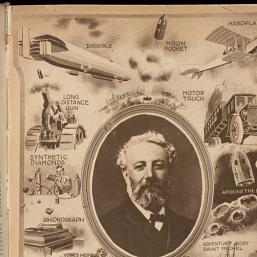
Hi everyone and welcome to the Finder’s Archives. This week, it’s going to be me musing a bit about something.
Generally speaking, it’s fairly well accepted that Tolkien is the father of fantasy, and Gary Gygax is the father of the Fantasy RPG. This may not be 100% true, but it is the general perception within the greater gaming community. Those are fairly well established as said, but where do we find the roots of Science Fiction, within games? Most people would say that Mary Shelley is one of the first Science Fiction writers, and probably the first notable author. But within the gaming areas, she’s really more of a horror author – some people would credit William Gibson, H.G. Wells or others as being the root of Science Fiction.
My postulate? Jules Verne. Not so much the father of Science Fiction, but definitely the forerunner of the Science Fiction (and to some degree modern and steam-punk) games that are popular today. His works – things like 20,000 Leagues Under the Sea, Journey to the Center of the Earth, and Around the World in Eighty Days are well known. All of these feature scenarios where technology that is way beyond the norm for the time (20,000 Leagues) or scenarios that are extremely unlikely, but not entirely impossible given enough technology (Journey and Around) are central themes. After all, while 80 days sounded insane back in Verne’s time, today, we can circumvent the world in 80 hours, quite easily. Who knows, one day we may make it to the Center of the Earth (though it isn’t hollow like his story – funnily enough, that inspired the Hollow Earth RPG campaign setting).
Jules Verne was born in 1828 and started writing somewhere around 1850 – but it took more than 100 years for the first Science Fiction RPG to make its way into the world: Metamorphosis Alpha, in 1976. Written by James M. Ward (a man who’s become a well-known name in RPG circles since, and who was part of the initial D&D runs) it is STILL available today (HERE). Unlike most modern RPGs, it is a rather small book at 36 pages, within which is contained everything you need to play the game on this irradiated spaceship. (Incidentally, it has a newer version too, which you can find HERE, which clocks in at 176 pages).
Even here the Sci-Fi RPG takes its inspiration from Jules Verne, in that it takes part on a space-ship (like From the Earth to the Moon) which is enormous, at some 50 miles long (the unlikely technology, like the Nautilus from 20,000 Leagues) and puts them into an unlikely scenario of having the ship being irradiated and things mutating all around them. Even something as simple as this 36-page game managed to grab the essence of science fiction from Jules Verne’s perspective, within its pages.
Then there is his influence on games like Castle Falkenstein, Steampunk games that have a remarkable level on unfeasible technology, driven by steam. Things that, more often than not, bring back memories of the Nautilus from 20,000 Leagues, and modern or pulp games like Adventure where you see incredible adventures on and within the earth itself.
